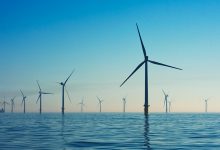We are living through a revolution in energy policy in Australia. I can not recall when last I sat down to write a column with as much relish as I am writing this one.
Last Friday, the Premier of Victoria announced that the Victorian Government had committed to a 9GW target (by 2040) for offshore wind, a target that he said would be “met and exceeded”. 2 GW is targeted by 2030, as set out in the Victorian Wind Policy Directions Paper.
The policy announcement scored a brief mention on the online business pages of some of Australia’s broadsheets. Scanning the newspapers this weekend, with one exception, I find nothing.
The journalists have missed a trick. In energy policy in Victoria, I think this announcement is the biggest thing since the Victorian Government, through the State Electricity Commission of Victoria, committed to the Loy Yang brown coal complex in the 1970s.
Let’s put some meat on the 9 GW bone and consider some of the implications. At current construction costs, I estimate that 9GW of offshore wind will involve capital outlays of around $35 billion.
That 9GW wind will produce around 40TWh of electricity annually (assuming a 50% capacity factor). This is well more than Victoria’s last three brown coal generators produce. It might reasonably be said that this policy alone will almost fully decarbonise electricity production in Victoria.
This 9GW of wind – assuming say 7GW off the Gippsland and Bass coasts and 2GW around Portland – is unlikely to require significant on-shore transmission to get its production to the main load centres in Melbourne and Geelong.
This is because they will take advantage of the onshore transmission networks catering to the Latrobe Valley coal generators to the East and the Portland smelter to the West.
Victoria’s on-shore wind and solar developers now need to re-examine their business cases, taking account of the Government’s unequivocal commitment to off-shore wind. On-shore solar, both large scale and rooftop is an obvious winner of this policy (its not strongly correlated to offshore wind).
Those considering hydrogen electrolysers now have a clearer indication of where to site – probably directly connected to offshore wind, much as Alcoa is exploring at its Portland aluminium smelter.
Why was such a major policy direction announced now? Let me speculate:
- First, I think the Victorian Government takes the climate crisis seriously.
- Second, it is now quite clear that coal generators are heading for the exits much more quickly than expected, and the generators’ retail arms will need to replace the power they produce and sell to their customers, if they want to retain those customers.
- Third, I imagine that the Victorian Government has given up on the prospect of meaningful decisions ever emanating from the quagmire of quasi-national policy and regulatory institutions.
- Fourth, offshore wind generation has demonstrated huge technology improvement and cost reduction. Though still more expensive per MWh produced at source (although not necessarily when measured at load), costs are declining quickly. In Britain the capital outlay in offshore wind per MW has declined 66% in the last five years. Britain already has 10.4GW of offshore generation (2,227 turbines) in operation. Another 5 GW is under construction and the Government is targeting 40GW – yes 40GW! – by 2030. This will mean that around half of Britain’s electricity, measured annually, is expected to come from offshore wind by 2030.
- Fifth, Victoria has excellent offshore wind resources along its southern coastline. The increasing maturity of prospective Victorian offshore wind developers, and the now deep global track record of offshore wind development provides the confidence needed for big decisions.
- Sixth, Australia is a now a wealthy and sophisticated country with landowners, Traditional Owners and conservationists who are aware of their rights and much better able to prosecute them, than once they were. As Ausnet Services is finding in Victoria and TransGrid is finding in New South Wales, gaining “social licence” for on-shore transmission is a great deal harder than they had imagined.
- Seventh, offshore wind generation is politically popular and is likely to secure bipartisan support.
Delivering such a huge policy quickly will be a thrilling challenge, not least when keeping in mind that there will be six state elections between now and 2040. As with the Government’s emission reduction policy and previous renewable energy targets, enabling legislation will be needed.
Offshore transmission hubs, production procurement processes, mechanisms for the allocation of costs and production to retailers and customers, amongst many things, will need to be developed.
Administrative institutions in Victoria will need to be established to deliver rapid and robust decisions. Then just think of the engineering, financial and construction opportunities to deliver the production.
Of more immediate concern, this announcement up-ends AEMO’s modelling of the Victorian power system. AEMO had not forecast any offshore wind generation in its “Step Change” (most likely) scenario over the next 30 years.
AEMO’s ISP team will need to go back to the drawing boards and the finalisation of the 2022 ISP will have to be delayed. Perhaps completely new analytical constructs are needed: is not an “optimal development path” a delusion in the context of such rapid technology and policy change?
Perhaps this announcement also tolls the bell for the aspiration of a “nation building” network of gargantuan interconnectors costing tens of billions of dollars. This dream (nightmare to my way of thinking) has smashed against the wall of political and economic reality.
Marinus Link – already dead in the water if you will pardon the pun – is now on its way to the crematorium. But let’s leave that for a forthcoming article.
Professor Bruce Mountain is the Director of the Victoria Energy Policy Centre










